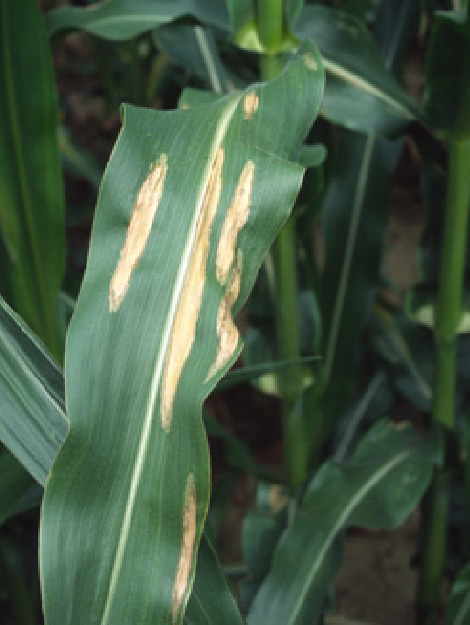Leaf blight of maize
Setosphaeria turcica
Profile
Turcicum leaf spot disease of corn, is caused by the fungus Setosphaeria turcica, which mainly attacks plants of the sweet grass family. Typical symptoms are translucent to brown spots on the upper surface of the leaves. The leaf infestation reduces the assimilation surface and thus disturbs starch storage and grain formation.
Biology
The fungus overwinters in the form of conidia and mycelium, but also as chlamydospores (spores that develop asexually from parts of the mycelium) on crop residues that remain on the soil. Starting from this material, conidia and further chlamydospores are formed in spring, which usually reach the lower leaves of the maize through rain splashes. The fungus finds optimal infection conditions at temperatures between 24 °C and 30 °C and prolonged leaf wetness (approx. 10 hours). Subsequently, new spores (conidia) are formed on the underside of the infected leaves, which are spread throughout the stand by the wind and set new infections. Primary infections can also occur with conidia introduced on the seed.
Damage symptoms

The symptoms of Turcicum leaf spot disease are long, narrow spots on the leaves that are at first watery translucent and eventually brown. At first, only single spots are noticed on the lower leaves. As the disease progresses, the upper leaf layers are also affected. If the infestation is severe, the fungus spreads over the entire leaf surfaces and can cause emergency ripening. Heavily infested corn stands look dirty gray from a distance, as if they have been damaged by frost.
Distribution
Setospaheria turcica is distributed worldwide on its host plants. In Austria, however, Turcicum leaf spot disease of maize occurs mainly in southern and southeastern maize-growing areas. In the foothills of the Alps in Lower and Upper Austria, heavy infestation is also possible due to warm and humid weather. In the Pannonian region, however, this disease is rare.
Propagation and transmission
The first infections originate from the filamentous cells of the fungus (=mycelium) and the fungal spores (conidia) that have overwintered on infested plant residues in the soil or on the soil surface. Further transmission of the disease takes place by means of spores, which are transported by wind.
The optimal conditions for spore formation and germination and thus for infection are warm temperatures and high humidity, e.g. also dew. If the weather conditions are optimal for the fungus, explosive multiplication can occur and entire fields can become infested very quickly.
Economic importance
The problem with fungal infestation is a reduction in the assimilation surface, which leads to impaired starch storage and grain formation. If infections occur at the time of flowering, grain yields can be reduced by up to 30%. In case of late infections or sporadic occurrence, yield losses are very low. The quality of the corn kernels, on the other hand, is not affected in any case.
Specialized information
BAES provides an up-to-date classification of varietal susceptibility of corn varieties to Turcicum leaf spot disease.
Last updated: 24.04.2024
automatically translated